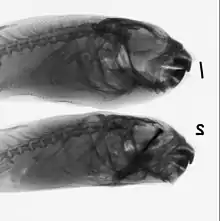Spotted puffer
Guentheridia formosa, the spotted puffer, is a species of pufferfish native to the coasts of the eastern Pacific Ocean from Costa Rica to Ecuador. This species grows to a length of 26 centimetres (10 in) TL. It is the only known member of the monotypic genus Guentheridia.
| Spotted puffer | |
|---|---|
 | |
| A radiograph of a spotted puffer's head | |
| Scientific classification | |
| Domain: | Eukaryota |
| Kingdom: | Animalia |
| Phylum: | Chordata |
| Class: | Actinopterygii |
| Order: | Tetraodontiformes |
| Family: | Tetraodontidae |
| Genus: | Guentheridia C. H. Gilbert & Starks, 1904 |
| Species: | G. formosa |
| Binomial name | |
| Guentheridia formosa (Günther, 1870) | |
Other common names for the fish include compère taché in French and tamborín and tamboril manchado in Spanish.[1]
Description
The spotted puffer has a white body with dense dark spots on its back and sides in various patterns, with variable yellowish markings. Its head is wider than it is deep, and is convex between the eyes. It as a single dorsal fin at its rear, a similar-shaped anal fin below, and in front of the pectoral fin it has a slit-like gill opening. The spotted puffer's tail fin is generally straight, and can be dusky or greenish.[2]
Habitat
Found in coastal shallow water at depths between 0-10 m, generally at the bottom on soft substrate such as mud or sand.[2]
References
- Nielsen, J.G.; Munroe, T. & Tyler, J. (2010). "Guentheridia formosa". IUCN Red List of Threatened Species. 2010: e.T183238A8078089. doi:10.2305/IUCN.UK.2010-3.RLTS.T183238A8078089.en. Retrieved 18 November 2021.
- "Species: Guentheridia formosa, Spotted puffer". Smithsonian Tropical Research Institute. 2015. Retrieved 27 March 2022.
External Links
Froese, Rainer; Pauly, Daniel (eds.) (2012). "Guentheridia formosa" in FishBase. October 2012 version.
